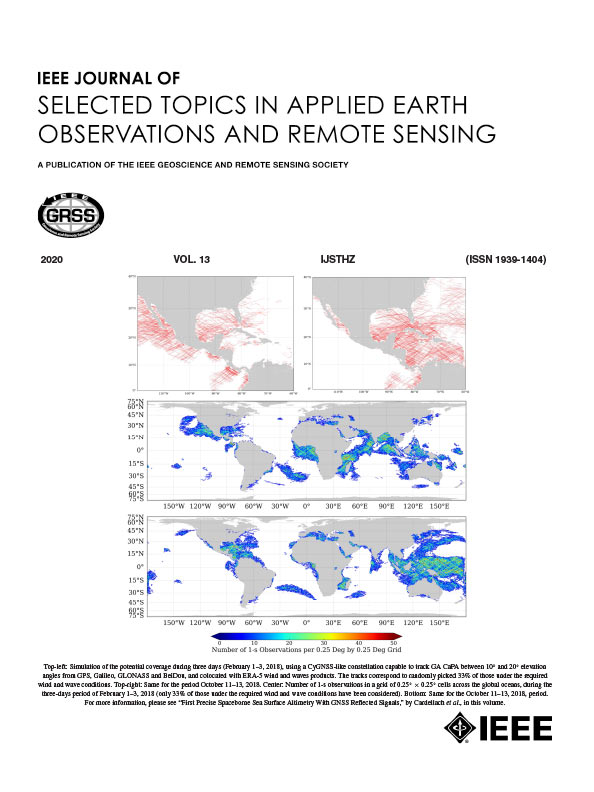Sentinel-2图像中基于视差的飞行器检测基准数据集和新方法
IF 5.3
2区 地球科学
Q1 ENGINEERING, ELECTRICAL & ELECTRONIC
IEEE Journal of Selected Topics in Applied Earth Observations and Remote Sensing
Pub Date : 2025-09-26
DOI:10.1109/JSTARS.2025.3615068
引用次数: 0
摘要
星载飞机监控是对地面监控系统的重要补充,为全球航空安全、高效、可靠运行提供有力支撑。大多数现有的飞机探测数据集来自静止卫星图像,这使得探测飞行中的飞机变得困难。尽管视频卫星图像可以提供运动线索,但其空间覆盖范围有限,使得捕捉稀疏分布在广阔区域的飞行飞机目标具有挑战性。哨兵2号卫星的每张图像覆盖数百公里的宽度,为监视飞行的飞机提供了有利条件。除此之外,其多光谱仪器的物理设计对多光谱图像中的移动物体产生视差效应,从而为检测飞行中的飞机提供了一种新的方法。基于Sentinel-2卫星多光谱图像,构建了空间分辨率为10 m的飞行器检测数据集(S2Aircraft)。数据集用定向边界框进行标注,包括RGB和NIR光谱带。此外,我们设计了一个高效的飞行飞机检测网络(FADet),该网络将输入图像映射到高维非线性特征空间,同时保持较低的计算复杂度。此外,对于单类目标检测任务,该模型采用半耦合头部实现高效检测。最后,根据S2Aircraft数据集中目标的几何特征,设计了损失函数,显著提高了定向目标检测的精度和稳定性。大量的实验证明了该方法的有效性和先进性。具体来说,在我们的S2Aircraft数据集上,FADet实现了具有竞争力的性能,达到每秒2.6千兆浮点运算,在50%交集时达到96.3%的平均精度(mAP)。在HRSC2016和CORS-ADD两个公共数据集上,FADet分别实现了90.90%和94.16%的mAP$_{50}$。本文章由计算机程序翻译,如有差异,请以英文原文为准。
A Benchmark Dataset and Novel Methods for Parallax-Based Flying Aircraft Detection in Sentinel-2 Imagery
Satellite-based aircraft monitoring is an important complement to ground surveillance systems, providing strong support for the safe, efficient, and reliable operation of global aviation. Most existing aircraft detection datasets are derived from still satellite imagery, making it difficult to detect flying aircraft. Although video satellite imagery can provide motion cues, its spatial coverage is limited, making it challenging to capture flying aircraft targets that are sparsely distributed over wide areas. Each Sentinel-2 satellite image covers a width of hundreds of kilometers, providing favorable conditions for monitoring flying aircraft. Beyond this, the physical design of its multispectral instruments induces parallax effects for moving objects in multispectral imagery, enabling a novel approach for the detection of flying aircraft. We construct a flying aircraft detection dataset (S2Aircraft) based on Sentinel-2 satellite multispectral imagery with a spatial resolution of 10 m. The dataset is annotated with oriented bounding boxes and includes both RGB and NIR spectral bands. In addition, we design an efficient flying aircraft detection network (FADet), which maps input images to a high-dimensional nonlinear feature space while maintaining low computational complexity. Moreover, for single-class object detection tasks, the model employs a semidecoupled head to achieve efficient detection. Finally, a loss function is specifically designed according to the geometric characteristics of targets in the S2Aircraft dataset, significantly improving the accuracy and stability of oriented object detection. Extensive experiments demonstrate the effectiveness and advancement of our FADet. Specifically, on our S2Aircraft dataset, FADet achieves competitive performance reaching 2.6 giga floating-point operations per second and 96.3% mean average precision (mAP) at 50% intersection over union. On two public datasets, HRSC2016 and CORS-ADD, FADet achieves mAP$_{50}$
求助全文
通过发布文献求助,成功后即可免费获取论文全文。
去求助
来源期刊
CiteScore
9.30
自引率
10.90%
发文量
563
审稿时长
4.7 months
期刊介绍:
The IEEE Journal of Selected Topics in Applied Earth Observations and Remote Sensing addresses the growing field of applications in Earth observations and remote sensing, and also provides a venue for the rapidly expanding special issues that are being sponsored by the IEEE Geosciences and Remote Sensing Society. The journal draws upon the experience of the highly successful “IEEE Transactions on Geoscience and Remote Sensing” and provide a complementary medium for the wide range of topics in applied earth observations. The ‘Applications’ areas encompasses the societal benefit areas of the Global Earth Observations Systems of Systems (GEOSS) program. Through deliberations over two years, ministers from 50 countries agreed to identify nine areas where Earth observation could positively impact the quality of life and health of their respective countries. Some of these are areas not traditionally addressed in the IEEE context. These include biodiversity, health and climate. Yet it is the skill sets of IEEE members, in areas such as observations, communications, computers, signal processing, standards and ocean engineering, that form the technical underpinnings of GEOSS. Thus, the Journal attracts a broad range of interests that serves both present members in new ways and expands the IEEE visibility into new areas.

 求助内容:
求助内容: 应助结果提醒方式:
应助结果提醒方式:


